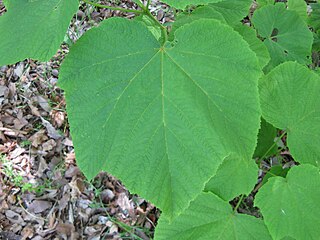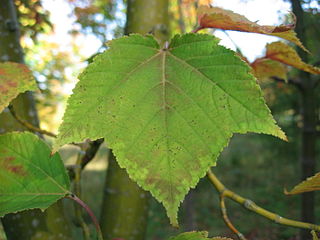Acer stonebergae is an extinct maple species in the family Sapindaceae described from two fossil samaras. The species is solely known from the Early Eocene sediments exposed in northeast Washington state, United States, and the adjacent area of south central British Columbia, Canada. It is one of three species belonging to the extinct section Torada.
Acer toradense is an extinct maple species in the family Sapindaceae described from two fossil samaras. The species is solely known from the Early Eocene sediments exposed in northeast Washington state, United States, and the adjacent area of south central British Columbia, Canada. It is one of three species belonging to the extinct section Torada.
Acer washingtonense is an extinct maple species in the family Sapindaceae described from one fossil leaf and four fossil samaras. The species is solely known from the Early Eocene sediments exposed in northeast Washington state, United States. It is one of three species belonging to the extinct section Torada.
Acer stewarti is an extinct maple species in the family Sapindaceae described from a series of fossil leaves and samaras. The species is solely known from the Early Eocene sediments exposed in south central British Columbia, Canada adjacent to northeast Washington state, United States. It is one of only two species belonging to the extinct section Stewarta.
Acer rousei is an extinct maple species in the family Sapindaceae described from a series of isolated fossil samaras. The species is solely known from the Early Eocene sediments exposed in south central British Columbia, Canada adjacent to northeast Washington state in the United States. It is the type species for the extinct monotypic section Rousea.
Acer browni is an extinct maple species in the family Sapindaceae described from a series of isolated fossil leaves and samaras. The species is known from the early to middle Miocene sediments exposed in Western Oregon, Washington state, USA and Northern Graham Island, Haida Gwaii, Canada. It is one of several extinct species placed in the living section Parviflora.

Acer smileyi is an extinct maple species in the family Sapindaceae described from a series of isolated fossil leaves and samaras. The species is known from the late Oligocene to middle Miocene sediments exposed in the states of Alaska, Idaho, Nevada, and Oregon, USA. It is one of several extinct species placed in the living section Parviflora.
Acer republicense is an extinct maple species in the family Sapindaceae described from a single fossil samara. The species is solely known from the Early Eocene sediments exposed in northeast Washington state, United States. It is the only species belonging to the extinct section Republica.
Acer ashwilli is an extinct maple species in the family Sapindaceae described from a group of fossil leaves and samaras. The species is solely known from the Early Oligocene sediments exposed in central Oregon, USA. It is one of several extinct species belonging to the living section Ginnala.
Acer clarnoense is an extinct maple species in the family Sapindaceae described from a series of isolated fossil leaves and samaras. The species is known from the late Eocene sediments exposed in the state of Oregon in the US. It is one of several extinct species placed in the living section Macrantha.
Acer dettermani is an extinct maple species in the family Sapindaceae described from a series of isolated fossil leaves. The species is known from the late Eocene to early Oligocene sediments exposed in the state of Alaska, USA. It is one of several extinct species placed in the living section Macrantha.

Acer latahense is an extinct maple species in the family Sapindaceae described from series of isolated fossil leaves. The species is known from the latest early to middle Miocene sediments exposed in the states of Oregon and Washington, USA. It is one of several extinct species placed in the living section Macrantha.
Acer palaeorufinerve is an extinct maple species in the family Sapindaceae described from series of isolated fossil samaras and leaves. The species was described from Miocene to Pliocene aged fossils found in Japan and is known from Korean fossils and Miocene sediments exposed in the state of Alaska, USA. It is one of several extinct species placed in the living section Macrantha.
Acer traini is an extinct maple species in the family Sapindaceae described from isolated fossil samaras. The species was described from Miocene-aged fossils found in Canada and the United States of America. It is one of several extinct species placed in the living section Glabra.
Acer taurocursum is an extinct maple species in the family Sapindaceae described from a single fossil samara found in Late Eocene lakebed sediments exposed in the state of Nevada, US. It is one of several extinct species placed in the living section Rubra.

Acer chaneyi is an extinct maple species in the family Sapindaceae described from a number of fossil leaves and samaras. The species is known from Oligocene to Miocene sediments exposed in Alaska, Idaho, Nevada, Oregon and Washington in the U.S. It is one of several extinct species belonging to the living section Rubra.
Acer whitebirdense is an extinct maple species in the family Sapindaceae described from a number of fossil leaves and samaras. The species is known from Miocene sediments exposed in Idaho, Oregon and Washington in the United States. It is one of several extinct species belonging to the living section Rubra.
Acer taggarti is an extinct maple species in the family Sapindaceae described from a number of fossil leaves and samaras. The species is known from Miocene sediments exposed in central Oregon, US. It is one of several extinct species belonging to the living section Rubra.
Acer lincolnense is an extinct maple species in the family Sapindaceae described from a group of fossil leaves and fruits. The species is known from Eocene sediments exposed in the US state of Montana. It is tentatively placed into the living Acer section Cissifolia.
Acer cascadense is an extinct maple species in the family Sapindaceae described from a series of isolated fossil samaras. The species is known from fossils found in Middle Miocene deposits of central Oregon. It is one of several extinct species placed in the living Acer section Negundo.



